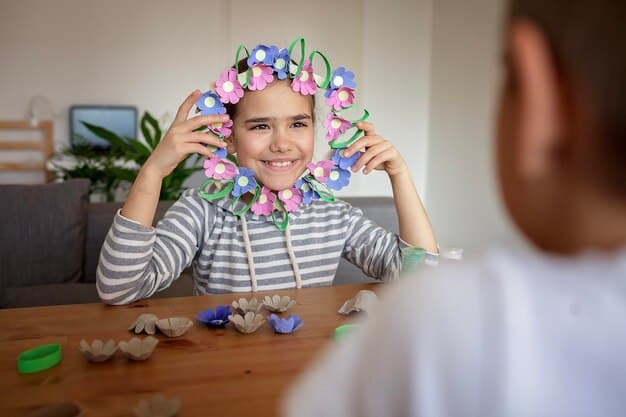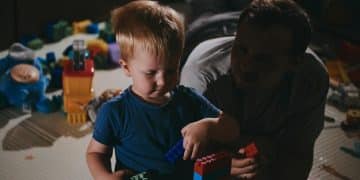Support for Children with ADHD: Focus & Hyperactivity Strategies

Supporting children with ADHD involves a multi-faceted approach combining behavioral interventions, structured environments, educational support, and professional guidance to enhance focus, manage hyperactivity, and foster overall well-being, enabling them to thrive academically and socially.
Navigating childhood can be complex, and for those with Attention-Deficit/Hyperactivity Disorder (ADHD), the journey often presents unique challenges. This article explores comprehensive strategies on How to Support Children with ADHD: Strategies for Improving Focus and Reducing Hyperactivity, offering practical insights for parents, educators, and caregivers seeking to foster a nurturing and effective environment.
Understanding ADHD: Beyond the Stereotypes
ADHD is a neurodevelopmental disorder characterized by persistent patterns of inattention, hyperactivity, and impulsivity that interfere with functioning or development. It’s crucial to move beyond common misconceptions and truly grasp the complexities of this condition. Children with ADHD are not “choosing” to be inattentive or disruptive; their brains are wired differently, affecting executive functions like planning, organization, and emotional regulation.
Recognizing the varied presentations of ADHD is key. Some children primarily struggle with inattention, often overlooked as simply “daydreaming” or being disorganized. Others display more prominent hyperactive-impulsive behaviors, which can be more disruptive in classroom settings or at home. A combined presentation, where both aspects are present, is also common. Early and accurate diagnosis is foundational to effective support, as it opens doors to appropriate interventions and resources tailored to a child’s specific needs.
The Neurobiological Basis of ADHD
- Brain Structure Differences: Research indicates variations in brain regions responsible for executive functions, such as the prefrontal cortex.
- Neurotransmitter Imbalances: Dopamine and norepinephrine, critical for attention and motivation, often function differently in individuals with ADHD.
- Genetic Predisposition: ADHD often runs in families, suggesting a strong genetic component.
Understanding these underlying mechanisms helps contextualize the behaviors observed in children with ADHD. It fosters empathy and shifts the perspective from viewing behaviors as willful defiance to recognizing them as manifestations of a neurological difference. This understanding is vital for creating effective support systems that address the root causes rather than just the symptoms.
Furthermore, recognizing co-occurring conditions, such as anxiety, depression, learning disabilities, or oppositional defiant disorder, is essential. These conditions can often complicate the presentation of ADHD and require integrated treatment approaches. A holistic view ensures that all aspects of a child’s development and well-being are considered, leading to more targeted and effective interventions.
In essence, supporting children with ADHD begins with a profound understanding of what ADHD truly entails. It requires moving past superficial judgments and embracing a scientific, empathetic, and comprehensive perspective that acknowledges the intricate interplay of biological, psychological, and environmental factors. This foundational knowledge empowers parents and educators to provide the most effective and compassionate care, fostering an environment where children with ADHD can genuinely thrive.
Creating a Structured Environment: The Foundation of Support
Establishing a structured and predictable environment is one of the most effective strategies for supporting children with ADHD. A predictable routine provides a sense of security and clarity, which can significantly reduce anxiety and improve a child’s ability to focus and self-regulate. Children with ADHD often struggle with transitions and unexpected changes, making consistent routines particularly beneficial.
Begin by creating a visual schedule for daily activities. This can be as simple as a whiteboard listing morning routines, school activities, after-school tasks, and bedtime rituals. Visual cues, such as pictures or symbols, can be especially helpful for younger children or those who process information better visually. This external structure compensates for internal organizational challenges, making tasks seem less daunting and more manageable.
Implementing Effective Routines
- Morning Routine: Break down tasks like getting dressed, brushing teeth, and eating breakfast into small, manageable steps.
- Homework Time: Designate a specific, quiet space and time for homework, free from distractions.
- Bedtime Routine: Establish a consistent sequence of events to signal winding down, such as bathing, reading a book, and quiet play.
Consistency is paramount. Sticking to the routine even on weekends and holidays helps reinforce good habits and reduces the likelihood of behavioral regressions. While flexibility is occasionally necessary, try to maintain the core structure as much as possible. This consistent predictability helps children with ADHD internalize routines, gradually improving their executive functioning skills.
Beyond daily schedules, create an organized physical space. Designate specific places for toys, clothes, and school supplies. Use labels, clear bins, and shelving to keep things tidy and accessible. A cluttered environment can be overwhelming and distracting for a child with ADHD, making it harder for them to find what they need or concentrate on tasks. An organized space reduces cognitive load and promotes independence.
Incorporating breaks into routines is also crucial. Short, active breaks can help children with ADHD release excess energy and reset their attention. For example, after 20 minutes of homework, a 5-minute break for jumping jacks or a quick stretch can be highly beneficial. These breaks are not rewards; they are essential components of an effective learning and functioning routine. By providing consistent structure and an organized environment, parents and educators lay a strong foundation for children with ADHD to develop focus, manage hyperactivity, and achieve their full potential.
Effective Behavioral Strategies: Nurturing Positive Habits
Behavioral interventions are cornerstones in supporting children with ADHD, aiming to reinforce desired actions and gradually reduce challenging behaviors. These strategies focus on positive reinforcement, clear expectations, and consistent consequences, helping children develop crucial self-regulation skills. The goal is not to suppress natural energy but to channel it constructively.
One powerful tool is a reward system. This could involve tokens, stickers, or points that can be exchanged for desired privileges or small rewards. When a child completes a task, follows an instruction, or manages to stay focused for a designated period, they earn a reward. The key is to make the rewards immediate and directly tied to the desired behavior, as children with ADHD often struggle with delayed gratification.
Key Behavioral Techniques
- Positive Reinforcement: Praise specific behaviors immediately (e.g., “I like how you sat still during story time!”).
- Clear Expectations: State rules and instructions concisely and positively (e.g., “Please use a quiet voice” instead of “Don’t shout”).
- Time-Outs/Breaks: Use as a cool-down period for emotional regulation, not always strictly as punishment.
Teaching social skills is another vital aspect. Children with ADHD may struggle with social cues, turn-taking, or managing impulsivity in group settings. Role-playing different social scenarios, discussing feelings, and providing opportunities for structured social interactions can help build these capacities. Encouraging participation in activities that foster teamwork or cooperative play can also be beneficial, providing natural contexts for social skill development.

Mindfulness practices, even in a simplified form, can also introduce children to the concept of self-awareness and emotional regulation. Simple deep-breathing exercises, or guiding them to notice their five senses, can help them pause, center themselves, and become more aware of their internal states. This can be a proactive tool for managing impulsivity and reducing hyperactivity before it escalates.
It’s also important to understand the concept of “antecedent-behavior-consequence” (ABC) analysis. Identifying what triggers certain behaviors (antecedents) can help in preventing them. For example, if a child struggles during transitions, providing a 5-minute warning before a change in activity can act as a helpful antecedent adjustment. This proactive approach is often more effective than simply reacting to challenging behaviors, providing children with the support needed to succeed.
Ultimately, consistent application of these behavioral strategies, coupled with patience and understanding, nurtures positive habits. It empowers children with ADHD by teaching them self-control and providing them with the tools they need to navigate their world more effectively, fostering a sense of accomplishment and increased self-esteem rather than relying on punitive approaches.
Academic Support and Learning Strategies: Unlocking Potential
Academic success for children with ADHD requires specific strategies that cater to their unique learning styles and challenges. Traditional classroom settings, with their emphasis on sustained attention and independent work, can be particularly demanding. Tailored educational support focuses on mitigating these difficulties and leveraging a child’s strengths.
Collaboration between parents, teachers, and school support staff is paramount. Developing an Individualized Education Program (IEP) or a 504 plan can provide necessary accommodations in the school environment. These plans outline specific support services, such as extended time for assignments, preferential seating to minimize distractions, or access to assistive technologies.
Effective Classroom Accommodations
- Preferred Seating: Near the teacher and away from windows or high-traffic areas.
- Reduced Workload: Breaking down assignments into smaller, more manageable parts.
- Movement Breaks: Allowing short, structured physical activity during long periods of sitting.
- Visual Aids: Using charts, diagrams, and colored papers to organize information.
Beyond formal accommodations, teaching explicit learning strategies can empower children. For example, breaking down complex tasks into smaller, step-by-step components makes them less overwhelming. Encouraging the use of planners, checklists, and color-coding systems can help with organization and time management. These executive function skills are often underdeveloped in children with ADHD, so direct instruction and consistent practice are essential.
Actively involve the child in the learning process. Hands-on activities, project-based learning, and interactive lessons can capture and maintain their attention more effectively than passive listening or reading. Incorporating movement into learning, such as pacing while reciting facts or using educational games that require physical interaction, can also be highly beneficial for children who thrive on kinesthetic input.
Feedback should be specific, timely, and positive. Instead of just “good job,” comment on what was done well (e.g., “I noticed you stayed focused for the whole math problem!”). When providing constructive criticism, focus on the behavior rather than the child’s character, and offer clear pathways for improvement. This builds self-efficacy and encourages continued effort, making the learning process less about compliance and more about genuine engagement and growth.
Furthermore, consider tutoring or specialized learning programs if a child continues to struggle despite classroom accommodations. These resources can provide individualized attention and targeted strategies that may not be feasible within a typical classroom setting. By implementing a blend of accommodations, explicit strategy instruction, and supportive feedback, educators and parents can unlock the full academic potential of children with ADHD, fostering confidence and a lifelong love of learning.
Diet, Exercise, and Sleep: Holistic Well-being
While often overlooked in the context of ADHD management, diet, exercise, and sleep play crucial roles in a child’s overall well-being and their ability to manage symptoms. Addressing these foundational elements can significantly complement other interventions and contribute to improved focus, reduced hyperactivity, and better emotional regulation. A holistic approach recognizes the interconnectedness of physical health and cognitive function.
Regular physical activity is particularly beneficial for children with ADHD. Exercise helps burn off excess energy, improves blood flow to the brain, and can enhance attention and executive functions. Activities that are engaging and allow for bursts of energy, such as team sports, martial arts, swimming, or even simply playing outdoors, can be highly effective. Aim for at least 60 minutes of moderate-to-vigorous activity daily.

Pillars of Holistic Health
- Balanced Nutrition: Focus on whole foods, lean proteins, fruits, vegetables, and complex carbohydrates.
- Consistent Exercise: Promote daily physical activity, especially outdoor and engaging options.
- Adequate Sleep: Establish a strict, calming bedtime routine and ensure sufficient sleep hours.
Dietary considerations are also important, though responses vary among individuals. While there’s no single “ADHD diet,” general recommendations include a balanced intake of fruits, vegetables, lean proteins, and whole grains. Some studies suggest limiting processed foods, excessive sugar, and artificial additives, as these might exacerbate symptoms in some children. Ensuring adequate intake of Omega-3 fatty acids, found in fish oil, flaxseed, and walnuts, has also shown promise in supporting brain health.
Sleep is non-negotiable for attention and mood regulation. Children with ADHD often experience sleep disturbances, which can worsen daytime symptoms. Establishing a consistent and calming bedtime routine is crucial. This might include a warm bath, reading a book, or quiet playtime, avoiding screens an hour before bed. Ensure the sleeping environment is dark, quiet, and cool. Adequate sleep helps the brain to reset and consolidate information, directly impacting a child’s ability to focus and manage impulses the next day.
Furthermore, mindfulness exercises, even for a few minutes daily, can teach children to become more aware of their bodies and minds. Simple focused breathing techniques can help calm the nervous system, reducing restlessness and improving overall self-regulation. These practices can be woven into daily routines, offering a practical tool for managing stress and enhancing inner calm.
By prioritizing a balanced diet, consistent physical activity, and sufficient sleep, parents and caregivers provide a strong foundation for managing ADHD symptoms. These holistic strategies support not only the physical health of children but also their cognitive and emotional well-being, contributing significantly to their ability to thrive.
Professional Guidance and Medication Options: Informed Choices
While environmental and behavioral strategies form the bedrock of supporting children with ADHD, professional guidance, including medication options, often plays a critical role for many families. Making informed choices about professional support and potential pharmacological interventions requires careful consideration, expert consultation, and a clear understanding of the benefits and considerations of each approach. It is not a singular path but a tailored journey.
Consulting with healthcare professionals is the first crucial step. A pediatrician, child psychiatrist, or developmental-behavioral pediatrician can provide an accurate diagnosis, rule out other conditions, and discuss various treatment avenues. These professionals can also guide parents in understanding the nuances of ADHD, including its co-occurrence with other conditions like anxiety or learning disabilities, which might influence the overall treatment plan.
Types of Professional Support
- Pediatrician/Specialist Consultation: For diagnosis and primary treatment plan.
- Therapy (CBT, Parent Training): To develop coping skills and behavioral strategies.
- School Psychologists/Counselors: For academic accommodations and support.
- Nutritionists/Dietitians: For dietary guidance where appropriate.
Behavioral therapy, particularly parent training in behavior management, is highly recommended. This therapy equips parents with specific strategies to manage challenging behaviors and promote positive ones. Cognitive Behavioral Therapy (CBT) can also be beneficial for older children and adolescents, helping them develop coping mechanisms, problem-solving skills, and strategies for managing impulsivity and emotional regulation. These therapeutic interventions empower both the child and the family.
Medication, when prescribed, is typically a stimulant or non-stimulant. Stimulants (e.g., methylphenidate, amphetamines) work by increasing certain neurotransmitters in the brain, helping to improve focus, reduce impulsivity, and control hyperactivity. Non-stimulants (e.g., atomoxetine, guanfacine) work differently and may be an option if stimulants aren’t effective or cause significant side effects. The decision to use medication is highly personal and should always be made in close consultation with a doctor, weighing potential benefits against side effects.
Regular monitoring of medication effectiveness and side effects is essential. Dosage adjustments may be necessary, and periodic re-evaluations ensure the treatment plan remains optimal as the child grows and develops. It’s not a set-it-and-forget-it approach; it requires ongoing dialogue with healthcare providers, noting any changes in behavior, sleep, appetite, or mood. Medication can be a valuable tool, but it’s most effective when integrated into a broader management plan that includes behavioral and environmental strategies.
Accessing educational advocacy services can also be invaluable for navigating school systems and securing appropriate accommodations. These professionals can help ensure that a child’s IEP or 504 plan is effectively implemented and reviewed. Ultimately, professional guidance provides a cornerstone for comprehensive ADHD management, enabling tailored support and ensuring that all available resources are explored to benefit the child’s well-being and developmental trajectory.
Fostering Strengths and Building Self-Esteem: A Child-Centered Approach
Supporting children with ADHD extends beyond managing symptoms; it critically involves recognizing and nurturing their unique strengths, interests, and talents. Children with ADHD often possess remarkable creativity, energy, curiosity, and resilience. Focusing on these positive attributes helps cultivate self-esteem, which can be vulnerable due to continuous struggles with demands on attention and behavior.
Identify areas where your child excels or shows genuine interest. This could be in arts, music, sports, technology, storytelling, or specific academic subjects. Provide opportunities for them to explore and develop these interests. When children are engaged in activities they enjoy and are good at, their motivation increases, and they often demonstrate sustained attention and focus that might be challenging in other contexts.
Strategies for Building Self-Esteem
- Celebrate Small Victories: Acknowledge effort and progress, not just perfect outcomes.
- Focus on Strengths: Highlight natural talents and provide opportunities for mastery.
- Encourage Hobbies: Support engagement in activities that bring joy and a sense of accomplishment.
- Provide Choices: Offering controlled choices gives a sense of autonomy and control.
- Teach Problem-Solving: Equip them with skills to navigate challenges independently.
Praise efforts and progress, not just outcomes. Children with ADHD may put in tremendous effort to complete tasks that others find easy. Acknowledging their persistence, diligence, and positive behavior, even when the final product isn’t perfect, reinforces their self-worth. Specific praise is more effective: “I appreciate how hard you worked on that math problem, even when it was tricky,” rather than just “Good job.”
Encourage self-advocacy. Teach children with ADHD to understand their own learning style and to articulate their needs. This might involve practicing how to ask a teacher for a break, for a quiet space, or for clarification on instructions. Empowering them to speak up for themselves builds confidence and helps them become active participants in their own support plan as they mature.
Allow for calculated risks and opportunities for independence. While structure is important, so is the chance to learn from mistakes and develop resilience. Giving children age-appropriate responsibilities, even if they sometimes forget or make errors, teaches them invaluable life skills and builds a sense of capability. The key is to provide a safety net while allowing them to grow.
Help them understand ADHD in a positive light. Explain that their brain works differently, not that it’s “broken.” Many successful individuals have ADHD, and reframing it as a unique way of thinking that comes with gifts like creativity, innovative thinking, and boundless energy can transform their self-perception. This positive reframe fosters a growth mindset, encouraging them to view challenges as opportunities rather than insurmountable obstacles. Ultimately, a child-centered approach that champions their strengths cultivates a resilient and confident individual, equipped to navigate life with ADHD.
| Key Strategy | Brief Description |
|---|---|
| 🏠 Structured Environment | Create predictable routines and organized spaces to enhance focus and reduce anxiety. |
| 🧠 Behavioral Techniques | Utilize positive reinforcement and clear expectations to foster self-regulation. |
| 📚 Academic Support | Implement accommodations and direct instruction in learning strategies at school. |
| 🩺 Professional Guidance | Consult specialists for diagnosis, therapy, and consideration of medication options. |
Frequently Asked Questions About Supporting Children with ADHD
Primary signs of ADHD in children typically include persistent patterns of inattention (difficulty sustaining focus, being easily distracted, forgetfulness) and/or hyperactivity-impulsivity (fidgeting, excessive talking, difficulty waiting turns, interrupting others). These behaviors must be more severe than expected for the child’s age and negatively impact their functioning in multiple settings, such as home and school, over a period of at least six months.
Routine is incredibly important for children with ADHD. A predictable structure provides a sense of security and significantly helps manage attention and hyperactivity. It reduces anxiety by making daily life more manageable and less overwhelming. Consistent schedules for waking, eating, homework, and bedtime help children internalize expectations, fostering better self-regulation and improving their ability to transition between activities.
While there isn’t a definitive “ADHD diet,” dietary choices can influence symptoms for some children. A balanced diet rich in whole foods, lean proteins, fruits, and vegetables is generally recommended. Limiting processed foods, excessive sugar, and artificial additives may be beneficial for certain individuals. Some research suggests Omega-3 fatty acids could support brain function, but any major dietary changes should be discussed with a healthcare professional.
Schools play a crucial role in supporting children with ADHD by providing accommodations and educational strategies. This can include preferential seating, reduced distractions, extended time for assignments, and breaking down tasks into smaller steps. Developing an Individualized Education Program (IEP) or a 504 Plan with the school allows for tailored support services and ensures that the child’s specific academic and behavioral needs are met within the learning environment to help them succeed.
Medication for ADHD is typically considered when behavioral and environmental interventions alone are not sufficient to manage symptoms that significantly impair a child’s functioning in daily life. This decision is made in close consultation with a healthcare professional, such as a pediatrician or child psychiatrist, who will evaluate the child’s specific needs, potential benefits, and possible side effects. Medication is often part of a comprehensive treatment plan that also includes therapy and adjustments to the child’s environment.
Conclusion
Supporting children with ADHD is a journey that demands patience, understanding, and a multifaceted approach. By combining structured environments, effective behavioral strategies, tailored academic support, consideration of holistic well-being, and professional guidance, parents and educators can create a nurturing ecosystem where children with ADHD can not only manage their symptoms but also thrive. Focusing on their unique strengths and fostering resilience ensures that these children grow into confident, capable individuals, ready to navigate the world with their distinct abilities, transforming challenges into opportunities for growth and success.





